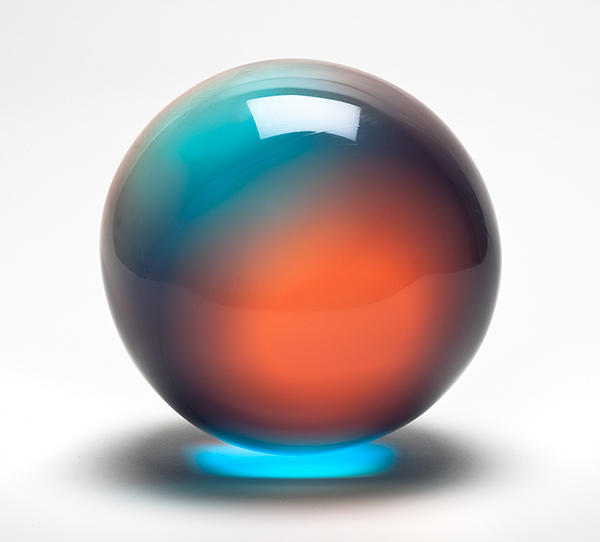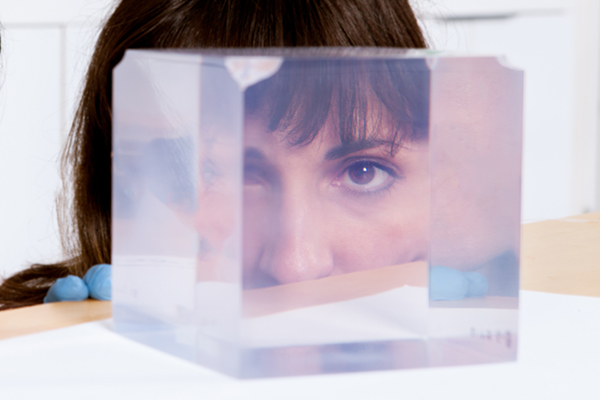Scientists work to conserve the distinctive pristine finish of postwar L.A. sculpture, working directly with the artists themselves
The “L.A. Look” conjures up images of perfect blue skies, palm trees, manicured Beverly Hills lawns, and, of course, Hollywood celebrities buffed and shined to a seeming flawless perfection. But it’s also a term that described the body of work of a group of Los Angeles-based artists working in the 1960s and ‘70s.
These artists—including Peter Alexander, Larry Bell, Billy Al Bengston, Ron Davis, Robert Irwin, Craig Kauffman, John McCracken, Helen Pashgian, De Wain Valentine, and others—embraced innovative fabrication techniques and materials from the world of industry, including resins, paints, and plastics. The artworks they created were inspired by the natural and human-made landscapes of Southern California and were characterized by bright, sensuous colors, and a pristine, flawless look that often required a lengthy polishing process.

Installation view of the exhibition Primary Atmospheres, David Zwirner gallery, New York, 2010. Photo by Cathy Carver, courtesy David Zwirner, New York/London. All artwork © 2013 the artists
Unfortunately, some plastic materials are neither as durable nor as long lasting as once hoped for. The surface of the artworks made of polished plastic, such as polyester or acrylic, is delicate and easily scratched, and thus extremely challenging to preserve. Maintaining the overall pristine finish intended by the artist means that the smallest damage requires attention. At the Getty Conservation Institute, scientist Rachel Rivenc is leading Art in L.A., a research project that is studying the industrial materials and fabrication processes used by the artists of postwar Los Angeles, as well as the implications these materials and processes have for conservation.
As part of this study, Rachel is conducting a series of video interviews with artists, engaging in conversations not only about their materials and fabrication processes but also about their thoughts on conservation and their artistic legacy. Artist dialogues with Peter Alexander and Larry Bell have been completed and are available online for conservators, curators, and art historians, as well as the interested public.

Helen Pashgian and Rachel Rivenc in the artist’s studio
A third dialogue, now in process, is with Helen Pashgian, whose work is currently featured in an exhibition at the Los Angeles County Museum of Art, Helen Pashgian: Light Visible. For this exhibit she has created her first large-scale sculptural installation.
Many of Pashgian’s earlier works are intimately scaled, translucent objects that incorporate vibrant colors and precisely finished surfaces. As the viewer moves around them, perception of these works shifts and they seem at times to be solid forms and at others to be dissolving into space. Given these important qualities, Pashgian has a very low tolerance for any sign of damage of her artwork. Her view that “if there is a scratch on the surface, that’s all you see” has important implications for the conservation of her works.

Untitled, 1968-69, Helen Pashgian. Photo: Brian Forrest
When an artwork made of polished plastic breaks or chips, achieving an inconspicuous repair is very difficult, as is finding a compatible adhesive. As a result, the artworks may undergo invasive treatments not proportionate to the extent of the damage—from extensive sanding and polishing to partial or total re-fabrication. To address this, Art in L.A. research includes a study of less-invasive repair methods for polyester and acrylic works of art—specifically adhesives and fillers to repair cracks, chips, broken parts, and losses on these works, drawing on methods and materials used for similar treatments on glass. The possibility of using various resins to re-saturate scratched areas without sanding or polishing is also being explored to preserve that flawless L.A. Look.

Rachel Rivenc examines a mock-up made from unsaturated polyester resin using compositions corresponding to those used by Los Angeles-based artists in the 1960s and 1970s
On June 10, join Rachel Rivenc for a free screening of the short documentary, Helen Pashgian: Transcending the Material, followed by a conversation with Pashgian about her artwork, materials, and processes, as well as her thoughts on conservation. Find out more and make a reservation.
Art in L.A. is a project that seeks to engage a wide mix of the Los Angeles art community—first and foremost artists, but also fabricators, conservators, and curators—in a creative dialogue about broader issues in the conservation of contemporary art. It is part of the larger Modern and Contemporary Art Initiative.




A very nice presentation, indeed!